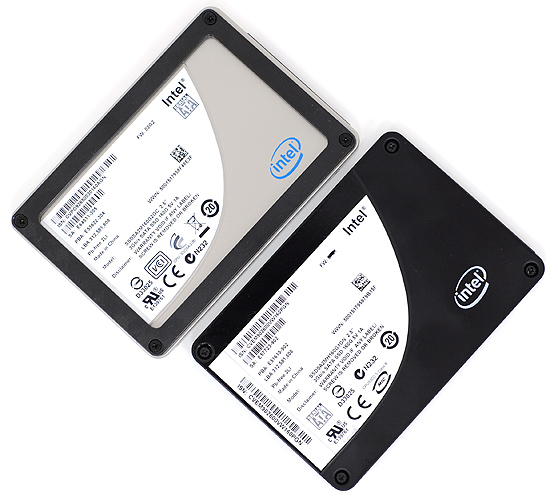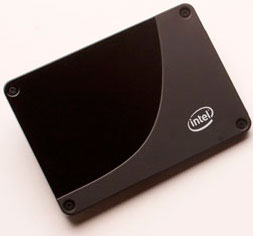Seagate Enters the Enterprise SSD Market with Pulsar
by Anand Lal Shimpi on December 7, 2009 11:59 PM EST- Posted in
- Storage
Seagate Goes Light on the Details
I will admit, I was disappointed when Seagate first approached me about Pulsar. Seagate is unwilling to discuss the manufacturer of their controller, nor are they interested in talking about any of the technology behind Pulsar. The only details we’re getting today are a handful of performance numbers, supported features, and commitment that Pulsar is shipping to OEMs.
First let’s tackle the controller question. I asked Seagate who made the controller in Pulsar and the best answer I got was that the drive uses a combination of Seagate and 3rd party IP. Translation? Someone else makes the chip, but perhaps Seagate has input into the firmware design.
Given the decades of experience Seagate has in making HDD firmware, I’m certain that some of that knowledge lends itself well to dealing with the intricacies of developing optimal SSD controller algorithms. Seagate is intimately familiar with the sorts of access patterns its customers are going to be using the most and I would be ashamed if Pulsar wasn’t heavily optimized for that.
It’s a big assumption on my part, because clearly the vast majority of players in the SSD space don’t get it right on the first try. The fact that Seagate isn’t entering the market with a splash lends me to believe that Pulsar isn’t quite perfect. Which is yet another big assumption on my part.
The controller does support idle time garbage collection similar to what both Samsung and OCZ have introduced on their drives. TRIM is also supported and enabled on the first drives.
Seagate doesn’t have an end user upgradeable firmware, but it doesn’t really matter for its first clients since Pulsar is an OEM exclusive right now. Seagate’s official stance on the issue was if you do it right the first time you don’t need to have an upgradeable firmware. Cocky, but most likely arrogance covering up the lack of a good strategy on Seagate’s part. This is something I expect to change by the time Seagate enters the consumer market.
Future Seagate SSD offerings will be available through retail channels, but Seagate wanted to address the enterprise OEM market first with Pulsar.
Pulsar uses SLC NAND, Available in 3 Sizes
Next we have the flash itself. Given the enterprise focus, Pulsar uses SLC NAND flash, putting it in a higher price, reliability and presumably performance class than the bulk of the SSDs we encounter.
There are three Pulsar models with 200GB, 100GB and 50GB of user accessible space on the drive (that's in Gigabytes, it's 186.26GiB, 93.2GiB, 46.56GiB in GibiBytes). The drives actually have 256GB, 128GB and 64GB of SLC NAND on them, the extra ~27% is used as spare area for cleaning/garbage collection/bad block allocation.

Seagate’s capacities indicate a 4 or 8-channel flash controller on the drive, compared to Intel’s 10-channel architecture (which is why Intel sticks to flash sizes that are evenly divisible by 10).
By comparison, Intel’s 64GB X25-E actually has 80GB of SLC NAND flash on the drive. Only 59.6GB is user addressable, meaning that roughly 25% of the total NAND on the X25-E is used as spare area.
The desktop 80GB X25-M has the same amount of NAND flash on the drive, but much less is dedicated as spare area. Only 6.9% of the X25-M is used for spare area.

Consumer drives like the X25-M use much less spare area
There’s a direct relationship between spare area, write amplification and performance as I’ve described before. The more spare area you have, the higher your performance will be, provided you have a controller that’s smart enough to use it. The more random your workload, the more you stand to benefit from a large amount of spare area. Highly random server workloads make good use of larger spare areas and thus most enterprise SSDs allocate more NAND to spare area.
Seagate threw a jab at Intel saying that the X25’s 20GB per day for 5 years lifespan rating wasn’t useful to the end user. Instead, Seagate is classifying the Pulsar SSD as having a 5 year useful lifespan. I’ll clarify what that means in a moment.
The performance specs of the drives are below:
| IOmeter Performance, Queue Depth = 32 | 200GB | 100GB | 50GB |
| Peak Read/Write IOPS 4K 100% Random | 30,000/25,000 | 30,000/25,000 | 30,000/25,000 |
| Sustained Read/Write IOPS 4K 100% Random | 30,000/10,500 | 30,000/5300 | 30,000/2600 |
| Peak Read/Write MB/s 128KB 100% Sequential | 240/220 | 240/220 | 240/220 |
| Sustained Read/Write MB/s 128KB 100% Sequential | 240/160 | 240/80 | 240/40 |
Seagate claims that the random read/write IOPS figures are on a conditioned drive, however Seagate wouldn’t tell me how the drive was conditioned. Seagate also provides two values for each score: peak and sustained. Peak, if in a conditioned state, most likely means the highest attainable value after a short period of activity. Sustained, according to Seagate, is the absolute minimum level of performance you should expect. Both are difficult to validate without a better understanding of Seagate’s methodology, which the company was unwilling to reveal to me.
The 50GB Pulsar (effectively a 64GB drive) is good for up to 2600 4KB random write IOPS (queue depth of 32) over the entire user addressable LBA range. Intel specs the 64GB X25-E at 3300 4KB random write IOPS. Peak performance is listed at 25,000, but it’s unclear how Seagate arrived at that number. I’m guessing it refers to a clean secure erased state, in which case that’s also under what I would expect from the X25-E.

Things change completely once we get to larger capacities. The 100GB drive pulls ahead at 5300 IOPS, while the 200GB drive can deliver 10,500 IOPS. Both of these values, if they are indeed derived after continuous testing on a preconditioned drive, are higher than Intel’s X25-E. Without a drive from Seagate there’s no way to confirm, but the performance data looks promising.
Intel has avoided delivering anything larger than the 64GB X25-E, if you need capacity, Pulsar can deliver it. Even if you don’t need capacity, you could theoretically dedicate even more flash to spare area and have an even faster SSD.
Sequential read/write speed is as you’d expect. 240MB/s for sequential reads and, used, 40 - 160MB/s depending on the drive capacity. The 50GB drive’s 40MB/s sequential write speed is disappointing, but the larger sizes are palatable. Such low write speeds are either artificial or the result of the same sort of issue that continues to plague Intel’s X25-M. It’s also a way of getting you to buy the larger (read: more expensive) drives.










52 Comments
View All Comments
juzz86 - Tuesday, December 8, 2009 - link
I just picked up on something the author said which I've never seen before but often wondered. If I were to format my 80GB X25-M G2 with a 70GB partition, would I see better performance having that extra 4.5GB set aside as spare area? Is this just a relatively simple way of getting even better speeds? Or am I barking up the wrong tree?GullLars - Tuesday, December 8, 2009 - link
If you have TRIM firmware and use the standard W7 drivers so the command actually hits the drive, you will see no difference as long as the ammount of used area is the same. With trim any free area is effectivly spare area. If you however run a RAID or use controllers or drivers that don't forward trim, you will see better _sustained_ write numbers with a smaller partition. In order for the drive to make use of this unpartitioned space, you either have to partition the drive when brand new, or directly after a Secure Erase.In reply to the article. It seems to me from the performance numbers that Segate might have fused its own IP with Intels and made it's own 8-channel controller. It would make perfect sense, and explain why the performance numbers of x25-E 64GB and Pulsar 50GB are so simelar.
It makes me a bit sad that Samsung didn't go for a 16-channel design on the higher capasity drives that will use 16 NAND chips or more, since this basically limits the random read IOPS and peak write IOPS. These 8-channel drives will have to go head to head with SandForce's SF1500, wich are 16-channel SLC drives targeting the same market.
BTW, i think all new high-performance SSD released in 2010 should start using SATA or SAS 6Gbps as standard to help accelerate adoption rates and remove an unnecessary botleneck (seq read).
jimhsu - Tuesday, December 8, 2009 - link
The distinction between peak and sustained performance is highly interesting. Performance profiles for today's SSDs (post JMicron) are highly complex, and depend on free space, recent writes, TRIM/GC availability, and any concurrent operations. For example, a recurring issue seems to be IO stalling when a large sequential write operation is taking place (i.e. copying a huge file to the SSD while trying to use the drive normally).Might Seagate have found a workaround to this? All things considered though, I would much rather see a max IO latency figure.
Proteusza - Tuesday, December 8, 2009 - link
Avoid the Streissand Effect (and its related effects) at all costs. Whenever a company withholds information or seems like it is withholding information, it makes them look bad.I'm not saying Seagate has anything to hide, but if it were more upfront with its technology and what forms part of the Pulsar, it would be in a stronger marketing position. Hiding information just doesnt do it for me, but I suppose I've been spoilt by Intel and AMD lately, which generally reveal almost everything about their new hardware.
Jovec - Tuesday, December 8, 2009 - link
This site is big enough now to demand a minimum set of specs and information if the product company wants to be reviewed.chen4119 - Tuesday, December 8, 2009 - link
What about STEC Mach8 SSD drive? They've qualified for EMC, IBM, and SUN enterprise storage systems and they did really well this year. How do they compare to Intel SSD drives or Indinix controller drives? Just wondering how come there are no mentions of STEC in this blog.mckirkus - Tuesday, December 8, 2009 - link
They're super high end enterprise drives. It's the same reason you don't see RAMSANs in WD Raptor reviews.yuhong - Tuesday, December 8, 2009 - link
Yea, back when Bill Watkins was CEO of Seagate, he promised that Seagate would sue SSD makers, and later indeed Seagate tried to sue STEC. That lawsuit was dropped in Feb 2009.gfody - Tuesday, December 8, 2009 - link
+1, I found out about STEC while evaluating an EMC SAN. Apparently they have their own controller and use MLC. Where's Anand with the scoop?pcfxer - Tuesday, December 8, 2009 - link
ugh EMC. A company that brags about firmware updates that don't require rebooting then release a CRITICAL firmware update that requires some....REBOOTING. As it turned out, that firmware (applied days before christmas) decided to choke and puke on MY CHRISTMAS DAY! EMC, never again.Let me save you the pain my friend, look else where. Thecus...iron storage, ixSystems, ANYONE but EMC.